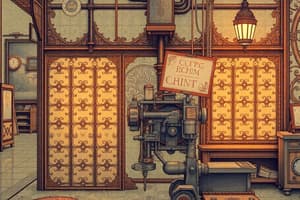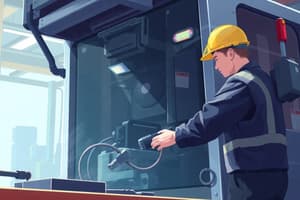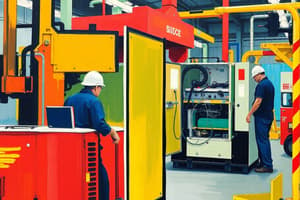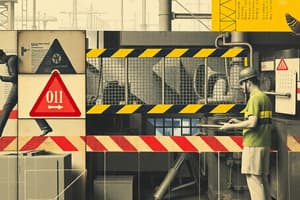Podcast
Questions and Answers
Match the following types of hazardous mechanical motion with their descriptions:
Match the following types of hazardous mechanical motion with their descriptions:
Rotating Motion = Smooth, slowly rotating shafts can grip clothing and force an arm or hand into a dangerous position Reciprocating Motion = Back and forth or up and down motion where a worker can be struck by or caught between moving and stationary parts Transverse Motion = Movement in a straight continuous line where a worker can be struck by or caught in pitch or shear points Fixed Guards = Provides a permanent barrier as a part of the machine
Match the following methods of machine safeguarding with their descriptions:
Match the following methods of machine safeguarding with their descriptions:
Interlocked Guards = Machine cannot cycle or start until the guard is back in place Adjustable Guards = Can be adjusted to facilitate different production operations Self-adjusting Guards = Moves according to the size of the stock entering the danger area Presence Sensing Devices = Uses systems of light for safety measures
Match the following devices used for machine safeguarding with their descriptions:
Match the following devices used for machine safeguarding with their descriptions:
Pullback Devices = Primarily used on machines with stroking action Restraint Devices = Use cables or straps attached to the operator's hands and a fixed point Safety Tripwire Cables = Located around the perimeter of or near the danger area for safety purposes Two-Hand Control Devices = Require constant, concurrent pressure to activate the machine
Match the following feeding and ejection methods with their descriptions:
Match the following feeding and ejection methods with their descriptions:
Match the type of safeguard with its description:
Match the type of safeguard with its description:
Match the mechanical hazard with its description:
Match the mechanical hazard with its description:
Match the type of safeguard with its primary benefit according to a supervisor:
Match the type of safeguard with its primary benefit according to a supervisor:
Match the method of machine safeguarding with its priority level:
Match the method of machine safeguarding with its priority level:
Match the description with the appropriate type of guard used for accident prevention:
Match the description with the appropriate type of guard used for accident prevention:
Match the component of mechanical system with its role in hazardous mechanical motion:
Match the component of mechanical system with its role in hazardous mechanical motion:
Match the following safeguarding mechanisms with their descriptions:
Match the following safeguarding mechanisms with their descriptions:
Match the following machine safety responsibilities with their roles:
Match the following machine safety responsibilities with their roles:
Match the following hazardous mechanical motions with their characteristics:
Match the following hazardous mechanical motions with their characteristics:
Flashcards are hidden until you start studying




